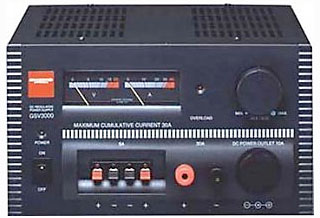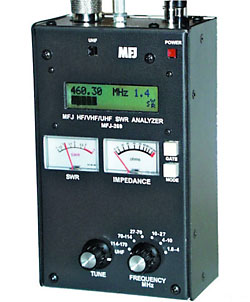Other equipment you may need
As well as a radio (transceiver) and an antenna you will need a few other pieces of equipment too. Here is a list of the main items:
Power Supply
 If you are using a handheld transceiver for use on VHF or UHF FM, you will probably use rechargeable batteries. But if you want to operate the radio without the battery (in your house for example), you may want to invest in a small DC power supply.
If you are using a handheld transceiver for use on VHF or UHF FM, you will probably use rechargeable batteries. But if you want to operate the radio without the battery (in your house for example), you may want to invest in a small DC power supply.
You will need to check what voltage your handheld works on as not all run on 13.8 V. Some have an adaptor that you can buy that will let you run it off a 13.8 V supply – it is worth checking.
If you are using a mobile or base station you will definitely need a 13.8 V power supply, although some base stations have their own built-in 230 V power supply.
The maximum current that the radio will need should be listed in the radio’s instructions, but a typical 100W HF radio might require up to 20-23 Amps. It is best to get a power supply that can comfortably handle this level of output.
Your equipment will only draw the current it needs so it you can quite happily buy a power supply that is more powerful than you require. In fact, it can be advantageous as you might want to upgrade to a larger radio in the future.
There are two main types of power supply on the market – linear and switched-mode.
The linear design uses a bulky transformer to change the 230 V mains voltage to 13.8 V dc. These power supplies tend to be large and heavy, especially the high-current models.
Switched-mode power supplies use a different approach. In the switching power supply, the AC voltage is converted directly to DC and filtered. This high-voltage DC is fed to a power oscillator that “switches” it on and off at a rate of about 20 to 500 kHz. The result is pulsating DC that can be applied to a transformer for conversion to 13.8 V.
The advantage is that the switched mode power supply can be made smaller and lighter, and is usually less expensive. The disadvantage of the switched-mode design is that some can generate interference signals that you can hear on your radio. If you’re considering a switched-mode power supply, look for models that boast low “RFI” (radio frequency interference).
Some have a small knob that you can turn to shift any interference away from the frequency you are listening on.
Coax
You will need something to connect your transceiver to your antenna. Most radios are designed with a 50 Ohm unbalanced output, which matches well with 50 Ohm Coax.
The other thing you have to think about is the quality of the coax and its inherent losses. Generally, the higher you go in frequency the greater the coax losses. So if you are only operating on the lower HF bands the thinner 5mm RG58 coax might suffice, as long as the run isn’t too long.
But if you are using the higher HF bands (24-28MHz), or 144/430MHz you will need to use different coax.
For general HF use RG213 is a good choice. It is thicker than RG58 and less flexible, but it does offer lower losses. It is also OK for use on 2 metres (144 MHz) and also 70cms (430MHz), although there are now better alternatives.
Newer coax types like WestFlex, Ecoflex, Aircell and Aircom Plus are better suited to VHF/UHF use, but will cost more than RG213.
SWR meter/Antenna Analyser
 Many modern radios have built in SWR meters, which are essential when setting up antennas. Also, many external antenna tuning units also have built-in SWR meters that make it easier to find a match.
Many modern radios have built in SWR meters, which are essential when setting up antennas. Also, many external antenna tuning units also have built-in SWR meters that make it easier to find a match.
If you are putting a radio into a car then you will definitely need to beg or borrow an SWR meter to set up the antenna correctly.
If you don’t have a built-in meter, and you are setting up a home-base antenna, an SWR meter can also be essential. When buying one make sure it covers the bands you require – some only cover HF and don’t work on VHF and above.
If you are very keen on experimenting with antennas an analyser can be a good investment. They are not cheap, but will tell you far more than just an antenna’s SWR. Some will give you graphical displays of the SWR curve, will allow you to detect faults in cables, measure cable length “electrically” and give information about an antenna’s reactance.
However, they are not for complete beginners and you might be better off in the first instance with a basic SWR meter.
Log book
It is no longer essential for you to keep a log of your contacts. However, most radio amateurs find log books very useful. Not only can you keep note of your contacts and the countries you have worked, but it can come in useful if there are any complaints about interference- your log will tell you and Ofcom what band you were on, or even if you weren’t transmitting at all!
A paper log is both inexpensive and easy to keep, but ultimately you might want to consider a computer log. Software is available for both PCs and Macs and varies from completely free to paid for.
The advantage of an electronic log is that it can automatically keep tabs on whom you have worked and on what bands. It can also tell you if you have worked someone before. Most electronic logging software packages will also print labels for your QSL cards, keep track of your progress on any awards you are chasing, upload information to the ARRL’s Logbook of the World system and much more.
Other pages in this section – Setting up your shack:










